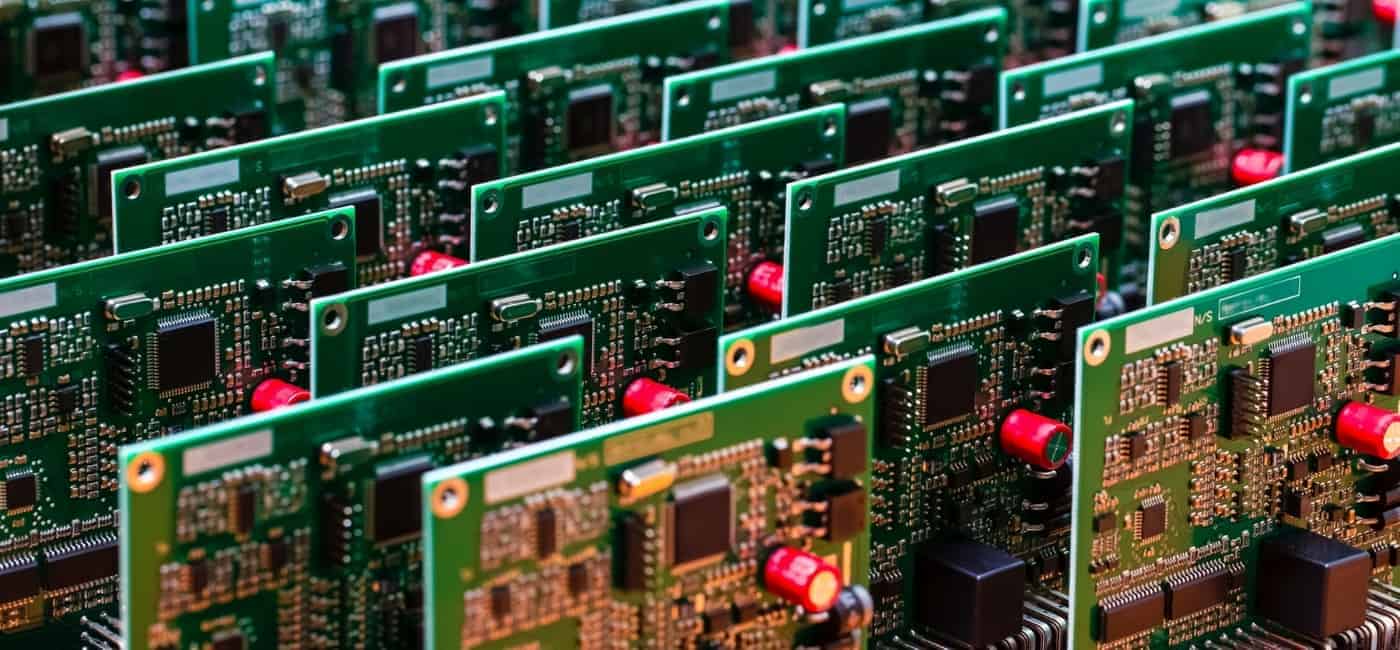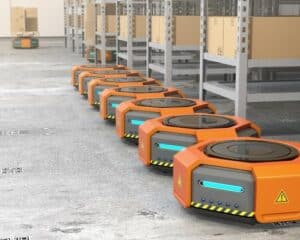
Reducing Risk of ESD Damage to PCBs in Military and Electronics Applications
As of January 12, 2021, ANSI/ESD S20.20 supersedes MIL-STD-1686C.
Mil Standard 1686 required ESD-sensitive devices to be fully enclosed in protective materials during transport, unless the risk of ESD damage could be mitigated. Most defense contractors took this requirement to mean they were required to use redundant packaging practices while handling ESD sensitive devices inside an ESD-protected area. Though this procedure is not required by ANSI/ESD S20.20, many electronics manufacturing and handling facilities follow the same protocol. Is it necessary?
In theory, there are ways to mitigate the risk of damage to printed circuit boards (PCBs) and other ESD-sensitive devices during transport. In practice, there will always be some risk if the PCBs are not fully protected. The Autonomous Mobile Robot (AMR) that transports devices from point to point could run over a static-generating floor surface, which would disrupt any ground connection, potentially damaging the PCB. If the AMR were to pass by an electronic field – i.e., other equipment or stored material holding a static charge – or if a person who wasn’t grounded walked by the AMR, the PCB could become charged.

If PCBs were on a cart preventing ESD damage would require this same level of control for anywhere the carts or Roombas went, with operators as well as all equipment and surrounding material fully grounded. Even with all these precautions, with PCBs moving freely about a production floor – where accountability is far lower than it is when people are handling an exposed board at a workstation – you’d still risk potential damage.
Without a mobile-equipment-grounding strategy the preferred material handling method would be to transport the PCBs in fully protected packaging then automate removal of packages at drop off points as needed. This would allow the use of standard AMRs without concern for all the other potential hazards. Otherwise, you need to identify all risk and enforce practices/procedures to mitigate all of those risks on top of grounding the AMR according to S20.20
In theory, there are ways to mitigate the risk of damage to printed circuit boards (PCBs) and other ESD-sensitive devices during transport. In practice, there will always be some risk if the PCBs are not fully protected. The Autonomous Mobile Robot (AMR) that transports devices from point to point could run over a static-generating floor surface, which would disrupt any ground connection, potentially damaging the PCB. If the AMR were to pass by an electronic field – i.e., other equipment or stored material holding a static charge – or if a person who wasn’t grounded walked by the AMR, the PCB could become charged.
Unless it were being handled at a static-safe workstation, to eliminate all risk the PCB could be enclosed in protective packaging. PCBs can be handled freely at stationary workstations because the environment is well controlled and all objects, including the technician, are at the same electrical potential: Technicians wear wrist straps and antistatic smocks; the work surface is ESD rated; and the surrounding area is cordoned off to prevent external electronic fields from entering the space.
If PCBs were on a cart preventing ESD damage would require this same level of control for anywhere the carts or Roombas went, with operators as well as all equipment and surrounding material fully grounded. Even with all these precautions, with PCBs moving freely about a production floor – where accountability is far lower than it is when people are handling an exposed board at a workstation – you’d still risk potential damage.
Without a mobile-equipment-grounding strategy the preferred material handling method would be to transport the PCBs in fully protected packaging then automate removal of packages at drop off points as needed. This would allow the use of standard AMRs without concern for all the other potential hazards. Otherwise, you need to identify all risk and enforce practices/procedures to mitigate all of those risks on top of grounding the AMR according to S20.20
Exposure and Vulnerability with ESD-preventive Measures In An Automated Environment
- Will personnel touch parts during automated movement? This is not a matter of whether parts are accessible but a question of process and purpose of automation. The typical answer to this question is no, that’s the reason for the automated process. In our experience, most companies that use automation in this way do not allow personnel to handle or touch parts while they are being transported by automated vehicles.
- How are the parts physically protected during automated movement? Are they in trays, and will the trays be moved and placed on an ESD-safe work surface? This is a critical question.
How would charges develop on moving vehicles? First, tribocharging is caused by friction as wheels move over the floor. Second, charges develop from induction: this occurs due to the presence of an electrostatic field while the assembly is grounded and when the ground connection near the same electrostatic field is disrupted. This is an often misunderstood concept but very easy to demonstrate. To put it mildly, the likelihood of incidence is less than low. This possibility can be eliminated if there is a conductive floor and the automated vehicle has conductive wheels.
- What is a charged device model (CDM)? When a vehicle docks or stops it can be grounded through a conductive floor or by a form of tethering. Why? We assume the person touching the parts will be grounded either with a wrist strap or ESD footwear. A grounded person is at an electrical potential of close to zero.
- Will personnel touch parts during automated movement? This is not a matter of whether parts are accessible but a question of process and purpose of automation. The typical answer to this question is no, that’s the reason for the automated process. In our experience, most companies that use automation in this way do not allow personnel to handle or touch parts while they are being transported by automated vehicles.
- How are the parts physically protected during automated movement? Are they in trays, and will the trays be moved and placed on an ESD-safe work surface? This is a critical question.
-
How would charges develop on moving vehicles? First, tribocharging is caused by friction as wheels move over the floor. Second, charges develop from induction: this occurs due to the presence of an electrostatic field while the assembly is grounded and when the ground connection near the same electrostatic field is disrupted. This is an often misunderstood concept but very easy to demonstrate. To put it mildly, the likelihood of incidence is less than low. This possibility can be eliminated if there is a conductive floor and the automated vehicle has conductive wheels.
- What is a charged device model (CDM)? When a vehicle docks or stops it can be grounded through a conductive floor or by a form of tethering. Why? We assume the person touching the parts will be grounded either with a wrist strap or ESD footwear. A grounded person is at an electrical potential of close to zero.
Reducing the Risks of PCB Damage
To reduce the risks of PCB damage, we recommend installing conductive wheels on carts along with establishing a no-nonsense handling process for when parts can and cannot be touched. We do not manufacture AMRs, so we cannot comment on the structural details of a Roomba, but if you are or may be handling Class 0 ESDS parts there is strong call for redundancy in processes.
ANSI/ESD S20.20 is the gold standard for designing and implementing an ESD program by defense contractors, FDA-compliant medical device manufacturers, mission-critical equipment manufacturers, raw component manufacturers and every commercial electronics entity. Most suppliers and electronics manufacturing and handling facilities already enforce S20.20. There is no penalty for exceeding the requirements in the standard or creating a redundant process to eliminate the human variable – i.e. installing grounded wheels on carts, enforcing a no-touch policy, and placing parts on SD surfaces before making physical contact.
We advocate against extra packaging or shrouding in the EPA. These time-consuming practices leave too much room for human error. Designing ESD-preventive solutions into equipment, processes and the building itself is a more robust preventative measure and does far more to reduce or eliminate the risk of ESD damage.
Get in Touch
The form below will help us better understand your needs and get you as quickly as possible to the right person. We look forward to helping you solve your static problem!
You can expect a response within 24 hours. For faster service, please give us a call: 617-923-2000
"*" indicates required fields
Visit our privacy policy to find out how we process data.

StaticWorx high-performance static-control floors protect electronic components, explosives, and high-speed computers from damage caused by static electricity. ESD flooring is part of a system. Choices should always be based on objective, researched evidence. When you partner with us, we look at all possible items that may need to integrate with the floor, and, focusing on your goals and objectives, help you find the right floor for your application.


 How would charges develop on moving vehicles? First, tribocharging is caused by friction as wheels move over the floor. Second, charges develop from induction: this occurs due to the presence of an electrostatic field while the assembly is grounded and when the ground connection near the same electrostatic field is disrupted. This is an often misunderstood concept but very easy to demonstrate. To put it mildly, the likelihood of incidence is less than low. This possibility can be eliminated if there is a conductive floor and the automated vehicle has conductive wheels.
How would charges develop on moving vehicles? First, tribocharging is caused by friction as wheels move over the floor. Second, charges develop from induction: this occurs due to the presence of an electrostatic field while the assembly is grounded and when the ground connection near the same electrostatic field is disrupted. This is an often misunderstood concept but very easy to demonstrate. To put it mildly, the likelihood of incidence is less than low. This possibility can be eliminated if there is a conductive floor and the automated vehicle has conductive wheels.





